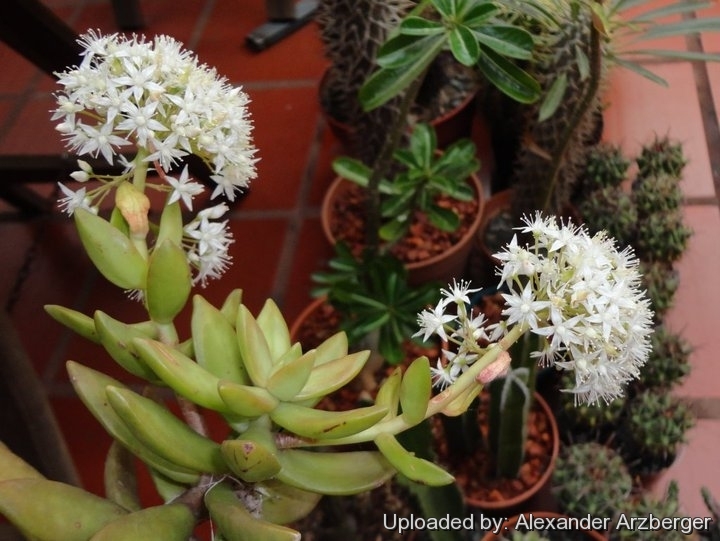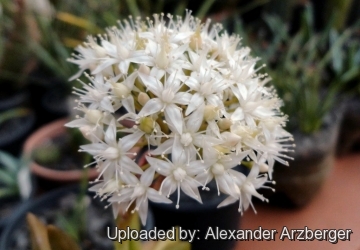




Your support is critical to our success.
Accepted Scientific Name: Sedum adolphii Raym.-Hamet
Notizbl. Bot. Gart. Berlin-Dahlem 5: 277 1912.

The flowers are small, pure white, star-shaped and fragrant.
Origin and Habitat: Mexico, Veracruz; locally naturalized in Sicily (Italy), on Fuerteventura (Canary islands) and north of New Zealand.
Habitat and ecology: Sedum nussbaumerianumSN|12382]]SN|27215]] grows naturally on rock walls of volcanic origin, and takes organic materials it needs from the decomposition of the leaves of a bromeliad (Hechtia tillandsioides) with which it he lives in symbiosis. On the rocky cliffs there is a rich succulent flora, including Mammillaria sartorii, Selenicereus coniflorusSN|7825]]SN|7825]], Echeveria carnicolorSN|27131]]SN|27131]], Sedum hemsleyanum, Sedum morganianumSN|27215]]SN|12382]], Beaucarnea recurvataSN|20517]]SN|20517]], Opuntia decumbens, Hechtia myriantha, Hechtia purpusii, Tillandsia grandis, and Agave pendula, among others.
Synonyms:
Sedum adolphii Raym.-Hamet
Notizbl. Bot. Gart. Berlin-Dahlem 5: 277 1912.
Synonymy: 3
- Sedum adolphii Raym.-Hamet
- Sedum nussbaumerianum Bitter
ENGLISH: coppertone stonecrop, Stonecrop, Coppertone Sedum, Nussbaumer’s Sedum, Golden Sedum
RUSSIAN (Русский): Очиток Нуссбаумера
Description: Sedum nussbaumerianum is a low growing, perennial succulent shrub to 20 cm tall by 50-60 cm wide (some old clumps, in nature, are around one meter wide). It has reddish-brown glabrous stems reclining on the ground but with ascending apex. The stems hold rosettes of yellow-green to orange, leaves that are pointed at their tips. It is one of the larger-leaved species (about 4 cm long), and turns bright yellow-orange when grown in full sun. In late winter to spring appear the white lightly fragrant flowers in a flat topped umbel-like inflorescence.
Stems: Decumbent glabrous. Over time, the stems become woolly and do not produce aerial roots.
Rosettes: Elongating 7,5 cm wide.
Leaves: Alternate, almond-shaped, acute, subterete (half cylindrical) convex and but obscurely carinate (recalling the hull a boat) dorsally, fleshy, olive-green becoming yellow-green to orange in full sun, principal leaves 22-39 mm long, 10-16 mm broad, 5-8 mm thick.
Inflorescences: Flowering branches ascending, axillary. Inflorescences cymes but appearing umbellate (with flowers more or less in the same plane), with a short primary axis. Pedicels 12-18 mm long. Flowers 5- (rarely 4-) merous, white or pale pink, slightly fragrant. Sepals broadly sessile, basally connate, ovate, acute, pale green, about 2.5 x 1.5 mm. Petals basally connate, lanceolate, acute, white, about 7.5 mm long, 2.8-3.2 mm wide. Filaments white. Anthers salmon-pink. Nectaries square, truncate and emarginate, white.
Seeds: Reticulate.
Chromosome number: 2n = 128.
Taxonomy notes: Sedum nussbaumerianum was first discovered by Carl Albert Purpus at a sulphur spring in a ravine at Zacuapan in Vera Cruz, Mexico in 1906 or 1907 but was later described in 1923 by the German botanist Bitter who named it for Ernst Nussbaumer, the head gardener at the Bremen Botanic Garden in Germany. It was in cultivation under this name in California in 1944 or perhaps as early as 1933 as Sedum adolphi and was re-introduced by the Huntington Botanic Garden through the International Succulent Institute as ISI 1682 in 1986 from material collected in the wild by Charles Uhl at 550-600m on a rock outcrop near Cerro Gordo, Veracruz Mexico in 1978 (HBG 40419). This plant was given the marketing name Coppertone by Magic Growers Nursery of Altadena, CA in 2002. The late Dr. Henk t' Hart and Dr. Bert Bleij wrote the Sedum section in the lexicon "Illustrated Handbook of Succulent Plants: Crassulaceae" (Eggli, Urs (ed), Springer. Berlin, 2003) and noted this species to be very similar if not identical to Sedum adolphi however Robert Clausen in "Sedum of North America North of the Mexican Plateau" (Cornell University Press. Ithaca, 1975) treated them as separate species in his book based on small differences in the inflorescences (Sedum adolphi has petals at different levels in cymes). However the facts indicate that S. nussbaurianum should be regarded as a synonym of S. adolphii. The two plants have the same chromosome count (x = 64), they came from plants grown from the same source (seeds gathered by Carl Purpus in 1907), and both have corymbiform inflorescences. With priority of 12 years, S. adolphii is the valid name.
Bibliography: Major references and further lectures
1) Urs Eggli “Illustrated Handbook of Succulent Plants: Crassulaceae” Springer Science & Business Media, 06 December 2012
2) Debra Lee Baldwin “Succulent Container Gardens: Design Eye-Catching Displays with 350 Easy-Care Plants” Timber Press, 20 January 2010
3) Cassidy Tuttle “Idiot's Guides: Succulents” Penguin, 01 December 2015
4) San Marcos Growers contributors “Sedum nussbaumerianum - Coppertone Stonecrop ” San Marcos Growers <http://www.smgrowers.com/products/plants/plantdisplay.asp?plant_id=3392>. 26 October 2016.
5) Georg Bitter; Notizblatt des Botanischen Gartens und Museums zu Berlin-Dahlem, vol. 8, n° 74, p. 281.
6) “Sedum nussbaumerianum Georg Bitter 1923” Fiche créée le 28/08/2010, mise à jour le 08/05/2011. Encyclopédie des Cactus, Plantes Grasses et Succulentes <http://www.cactuspro.com/encyclo> Web. 25 Oct. 2016.
7) Miguel Cházaro, David Jimeno-Sevilla, & Amparo Alvalat-Botana “The Sedum morganianum habitat discovered” <http://www.crassulaceae.ch/uploads/files/pdf/Sedum/sedum%20morganianum.pdf>
8) MIGUEL CHÁZARO-BASÁÑEZ, CESAR VIVEROS-COLORADO & DAVID JIMENO-SEVILLA “Sedum adolphii, Carl Albert Purpus, and the Sulphur Spring mystery” Cactus and succulent Journal, Volume 82, number 1, 2010

Sedum nussbaumerianum Photo by: Alexander Arzberger
The gallery now contains thousands of pictures, however it is possible to do even more. We are, of course, seeking photos of species not yet shown in the gallery but not only that, we are also looking for better pictures than those already present. Read More...
Cultivation and Propagation: Sedum nussbaumerianumSN|27215]]SN|27215]] (Coppertone Stonecrop) has a beautiful yellow-orange colour when it receives enough sunlight. It is a great plant for the rock or succulent garden or in a decorative container. In the Spring this plants produces heads of fragrant starry white flowers. It clumps easily and grows well from cuttings.
Exposure: Plant in full sun to light shade.
Soil: Grow it in a well-drained soil.
Waterings: Irrigate little to occasionally. Color will be best in the sun with little water.
Hardiness: Reported to be borderline hardy (Hardy to at least -2° C) in dry areas although needing protection from wet winters and severe frost.
Maintenance: Cut back stems and re-root when plants become too leggy.
Propagation: Cuttings. New plants can be started from as little as a single leaf.
| Your Actions | |
|---|---|
| Back to Sedum index | |
| Back to Crassulaceae index | |
 |
Back to Succulents Encyclopedia index |
Privacy stantement - Terms and conditions - How to cite - About us - Feedback - Donate



